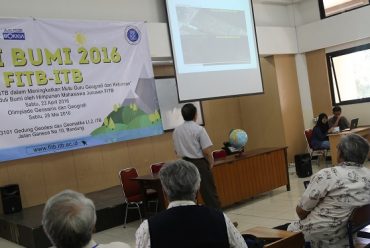Flooding in the city of Bandung … How Can?

http://djokowiratmo.blogspot.co.id
Monday (10/24/2016) during two hours of heavy rains in Bandung from 11:30 am until 13:30 pm and unexpectedly earlier parts of Bandung, especially the area that has not been hit by devastating floods were flooded. No half-hearted, the altitude is more than one meter. Pasteur or road tolls Junjunan which is entering the mouth of Bandung hit by devastating floods. Of the many social media news spread in a chain shows how such vehicles in the Livina Pagarsih swept away and there are even cars and two-wheeled vehicles are carried by river currents. As of this evening there is still a vehicle that is not discovered its existence. As I write this post, the rain was still flushed the city of Bandung, though not so heavy. This afternoon of rain in some places.
This afternoon lecture on the occasion of Tropical Meteorology, I take care of, I invite the students to analyze these events, make predictions, and provide solutions on how best to forward both mitigation and adaptation-related flooding. 2 hours of lecture time seemed too fast to achieve that goal. Here are some analyzes, predictions and solutions submitted by the students.
“According weather.meteo.itb.ac.id, rainfall in the city of Bandung on April 21 to the October 24, 2016 was recorded respectively by 17, 6, 13, and 36 mm. Accumulated amount of rainfall in a few days it was one of the causes of flooding in Bandung. According to BMKG, rainfall intensity light is at 5-20 mm / day and moderate rainfall of 20-50 mm / day. Data BMKG stated that on the day of the event (Monday), recorded 77.5 mm of rainfall in one hour, which is very dense category. Based on satellite imagery Himawari 8 (weather.is.kochi-u.ac.jp) showed that on the day of the incident, especially in West Java Java covered in low cloud that is suspected of clouds that potentially cause the rain nimbostratus and Cumulus. Also based on the data bom.gov.au (BMKG his Australia), the index value IOD (Indian Ocean Dipole) is negative, which means that the SST (sea surface temperature) in the eastern part of the Indian Ocean region (west of Sumatra equator) warmer than in Indian Ocean imur equatorial Africa. This leads to high convection and evaporation process more quickly, which triggers the formation of convective clouds which cause heavy rain. In addition, the southern oscillation index (SOI) shows the positive value of more than 7. This indicates that in the Pacific Ocean La Nina occurs. This event coincided with the sea surface temperatures in parts of Indonesia are higher with anomalies of 0.5-1.5 ° C above normal. According earth.nullschool.net there is low pressure in the southern region of Java. With streamlined support, the formation of rain clouds allow occurred in West Java, especially Bandung. Locally, the relative humidity at an altitude of 850, 700, and 500 millibar over Bandung at the time of yesterday by 82%, 84% and 92%, or very high. This provides further support for the rain.
From the point of environment, rain fell for six consecutive days is likely to cause the land in Lembang become saturated and unable to accommodate the rain water again. As a result of Lembang soil is already saturated the rain water will overflow (run off) which causes the river water discharge Citepus be increased dramatically. In addition, conditions of Lembang itself which has cracks in the surrounding area of Lembang fault causing the leakage of the aquifer so that the water flow faster. Citepus shallow river situation due to garbage and sediment erosion aggravate the overflow flow causing floods. Urban drainage is not functioning properly so that water does not flow smoothly. Land use change from green to land settlement in northern Bandung make maximum rain water can not undergo the process of infiltration and percolation. Topography support the flow of water rushing into the valley in the central and southern part of Bandung. As recognized also by BPLHDs Jabar that region, such as Pasteur, Pagarsih, Gedebage, and Antapani the lowest area of Bandung where Gedebage was fourth among the lowest. The topography is such that the water flow will be stacked on the lower region. Pembangungan housing around Pasteur also contributed to the reduction in water catchment areas.
Accu weather predictions based on the condition of one week to the next, chances highest rainfall occurred on October 27, 2016 amounted to 23 mm, followed on October 28 by 22 mm with a chance of 70%. On the possibility of thunder by 60% with a 96% cloud cover. In the next few days, cloud cover over Bandung amounted to 81-98%. Based on climate index BoM Australia, until next November, IOD still be negative thus increasing the chances of convective clouds in western Indonesia. Therefore, it is most likely to occur heavy rain in many places, including Bandung. Rain will continue to occur until the peak of the wet months (DJF) when monsoon Asia rose. With the conditions described above, there are many chances of flooding in the city of Bandung when no measures swiftly to overcome them. Early warning system must be constructed so as not to cause loss of life and property more. Besides this, here are some steps that might be taken.
1. Rain water harvesting
2. Promotion of biopori and infiltration wells
3. Widening culverts, toll manufacturing of water, and the normalization of drainage channels
4. Construction of water pumps in areas prone to flooding
5. Mapping of flood prone areas
6. Policy setting land use and city planning
7. Reforestation reproduced
8. Encouraging people to environmentally conscious and extreme weather.
Approximately thus discussed in such a short time. Of course there are still many things not yet unassessed or missed “. Salam alert !!








No Comments